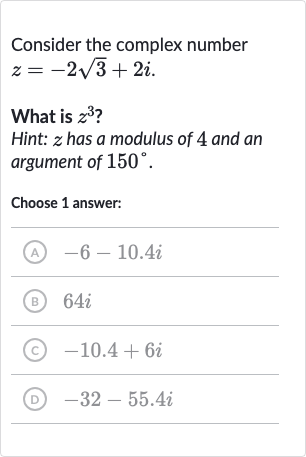Full solution
Q. Consider the complex number .What is ?Hint: has a modulus of and an argument of .Choose answer:(A) (B) (C) (D)
- Given complex number: We are given the complex number . We are also given that has a modulus of and an argument of degrees. To find , we can use De Moivre's Theorem, which states that , where is the modulus and is the argument of the complex number.
- Convert to radians: First, we convert the argument of degrees to radians because trigonometric functions in the complex plane are typically expressed in radians. degrees is equivalent to radians.
- Apply De Moivre's Theorem: Now we can apply De Moivre's Theorem. We have and . We want to find , so we raise the modulus to the power of and multiply the argument by .
- Simplify argument: Using De Moivre's Theorem, we get: Since the sine and cosine functions are periodic with a period of , we can simplify the argument to by subtracting (which is one full period) from .
- Find cosine and sine: Now we can find the cosine and sine of : So,

